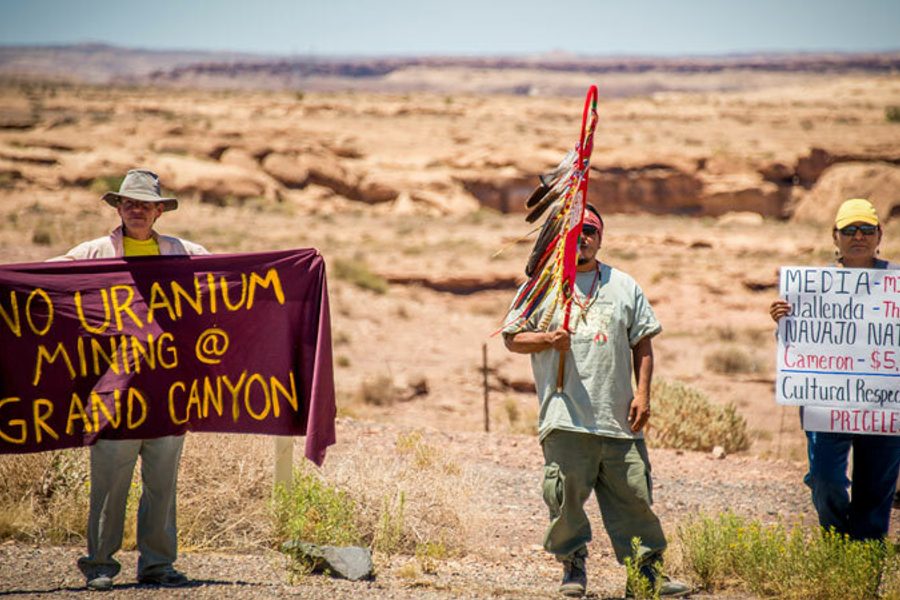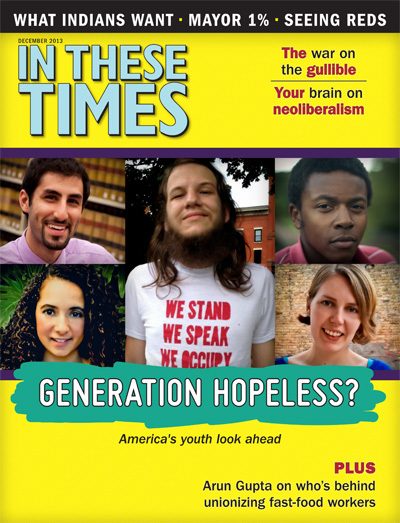What Indians Want
For starters, sovereignty over tribal membership and resource development.
Thomas King

A future. What a good idea. But there’s a problem. If Native people are to have a future that is of our own making, such a future will be predicated, in large part, on sovereignty.
One of the contentions currently in vogue is that Native people in North America need to be rescued from reserves and reservations, Canada’s Indian Act, the Canadian Department of Indian Affairs, and the U.S. Bureau of Indian Affairs. Aboriginal people have suffered unduly from government interference and bureaucratic oppression, so the thinking goes, and the only solution is to abrogate treaties, eliminate federal guarantees, divide First Nations land into fee-simple blocks, and allow Native people to participate freely in the economic markets that Western capitalism has created.
Tribes are obsolete forms of governance. Treaties are an obstacle to Native – non-Native rapprochement.
Slade Gorton, the Washington State politician, made a political career out of pursuing a termination vendetta against the tribes in his state and around the nation. In 1998, Gorton sponsored a Senate bill, which he disingenuously called “The American Indian Equal Justice Act.” The legislation was a direct attack on tribal sovereignty. Item 8 under “Findings” argued that the idea of Native sovereignty “frustrates and provokes social tensions and turmoil inimical to social peace,” while item 9 called on Congress to do away with Indian sovereignty because “no government should be above the law.”
To his credit, Gorton did not stand with the angry mobs who gathered in Wisconsin during the Walleye War of 1989 to throw rocks at Indians and shout racial epithets, including old favorites such as “timber niggers” and newer creations such as “welfare warriors,” nor did he hold up one of the signs that said “Save a Fish, Spear a Squaw, Save Two Fish, Spear a Pregnant Squaw.”
Still, he probably agreed with the resolution that John Fleming introduced at the 2000 Washington State Republican convention that called for the termination of all tribal governments in the state. Fleming bragged that if the tribes resisted such an effort, “then the U.S. Army and the Air Force and the Marines and the National Guard are going to have to battle back.” You might want to write Fleming off as a clown and his resolution as a piece of political rhetoric, but the resolution passed on a vote of 248 in favor and 2 against and became part of that state’s Republican Party platform.
All else considered, the main attraction of this line of reasoning is that it is simplistic and requires no negotiation or compromise. Let’s get rid of Indians as a legal entity, and let’s do it now.
The wonderful irony of Aboriginal sovereignty is that if we collected the Indian Act, the treaties, the Canadian and U.S. constitutions, the Canadian Charter of Rights and Freedoms, the U.S. Bill of Rights, all the Supreme Court decisions, along with the cases that the Canadian Human Rights Commission has generated, we would have a composite and contradictory manuscript much like the Bible. A manuscript in which both saints and scoundrels can find satisfaction and validation for contrary principles and beliefs in the same passage, where they can find a precedent for every comfort and every larceny.
But perhaps discussing sovereignty as an absolute concept is a waste of time. Perhaps we should concern ourselves instead with practical sovereignty and ask the question, what part of sovereignty is critical to Aboriginal Nations in North America? Each Nation will, of course, have to answer that for itself. However, I suggest that we concentrate on the issues of tribal membership and resource development. In Canada, Native people are divided, more or less, into three categories: Status Indians, Treaty Indians, and non-Status Indians. In most instances, Status Indians and Treaty Indians are the same. Legal Indians. Non-Status Indians are simply not Indians, or, more accurately, not Legal Indians.
In the United States, Legal Indians are members of a tribe that is recognized by the federal government, while the rest of Native people in that country are, like their counterparts in Canada, not Indians. In fact, with the passage of the Indian Arts and Crafts Act in 1990, Native artists who produce and sell their work cannot call themselves by their tribal affiliation unless they are official members of the tribe. To do so is to risk fines of up to $250,000.
The Arts and Crafts Act was designed to stop the trade in counterfeit “Native art” that unscrupulous dealers were bringing in from places such as Japan, Taiwan, Korea, and India, and in this regard, the act was a welcome law. But the unfortunate side effect of the act was to “terminate” a great many Native artists who were Indians by blood but who, for a variety of reasons, were not official members of a tribe. Many of them had home communities. Many of them had blood relatives living in those communities. Yet under the terms of the act, they could be prosecuted for claiming they were who they were because, legally, they weren’t.
Today, almost all Aboriginal Nations control their memberships. While the rules and regulations differ from tribe to tribe, band to band, the general requirement is that a blood relationship exist between a registered Indian or an ancestor on the tribal rolls and an individual seeking membership. Sometimes there is a blood-quantum requirement as well. The Blackfoot in Alberta and the Comanche in Oklahoma, for example, currently require that, in addition to a blood tie, their members be at least one-quarter blood. But they could, if they wished, lower that blood-quantum requirement or dispense with it altogether. This is what the Ottawa, Seminole, Wyandot, Creek, Choctaw, and Chickasaw have done. For these tribes and others, any descendant of a tribal member is also entitled to be a member of the tribe, regardless of blood quantum.
Currently, the trend among bands and tribes in North America is to try to limit membership. The land base and the resources that Native people control are finite. But Aboriginal populations continue to grow, and the thinking is that tribal assets should only be used for the benefit of those who are “authentic,” a term that is fraught with dangerous assumptions and consequences. Among the Cherokee, you have Cherokees who are Cherokee by blood and who have an ancestor on the required rolls, and you have Cherokees who are Cherokee by blood but whose ancestors were not listed on the required rolls. The one group is “authentic.” The other group is not.
To my way of thinking, such a distinction is self-serving and self-defeating at the same time.
Sovereignty allows that Aboriginal Nations can either erect barriers to membership or lower those barriers and create new opportunities for citizenship. Barriers can create security. Numbers can create strength. In the 21st century conversation around tribal membership, I hope that Aboriginal Nations use this sovereign power with intelligence and generosity.
After membership, the second question that Native people have to consider with regards to sovereignty is how we go about creating an economic base for reserves and reservations. There are almost as many Native people on reserves as off reserves, and while off-reservation Native-run businesses are important to the overall health of Native as well as non-Native communities, the development and expansion of on-reservation enterprise is critical if we expect to maintain our communities and our land base.
Up to this point, while reserves and reservations with a large land base have had more economic choices than those with a small land base, the range of the choices itself has been limited. And some of the choices have been downright disquieting.
Garbage dumps, for example. In the late 1980s and 1990s, North America decided that Native land would be a perfect place to dump its garbage. Waste management companies that handle everything from non-hazardous materials to nuclear waste began riding into Indian country armed with beads and promises, hell-bent on convincing tribal leaders that turning part of the reservation into a landfill was good economics. This scenario made for excellent theater of the absurd, with the waste management companies suddenly championing Native rights and tribal sovereignty. Not that these companies gave a damn about Native sovereignty. But they were excited by the prospect that the legal status of Indian land might protect them from the tyranny of environmental regulations.
I don’t want to suggest that Native communities were simply victims or that they were completely opposed to the enterprise of garbage disposal. Many reservations were so poor that any business was good business. From small tribes such as the Campo Band of Mission Indians outside San Diego to larger groups such as the Chickasaw and Sauk and Fox in Oklahoma, the Yakama in Washington, and the Mescalero Apache in New Mexico, First Nations began approaching companies to talk about joint ventures that would create commercial landfills on trust land and generate much-needed money for the community.
The garbage issue was, as might be expected, controversial, and the debate split many of the tribes. What was mildly amusing was watching environmentalists and concerned non-Natives lecture Indians on traditional beliefs and ethical standards. While Native people have, for a long time now, been adversely affected by White development near reservations and reserves— the mercury poisonings at Grassy Narrows in northern Ontario, the General Motors landfill near Akwesasne, the draining of Pyramid Lake in Nevada, the Kinzua Dam in Pennsylvania — the level of concern seems far greater, the reaction more intense, when White communities are faced with the consequences of Native development.
John Dossett, the general counsel for the National Congress of American Indians, sees the land-use battles as a reflection of race and privilege. “It is more than a little unfair,” says Dossett, “that tribes, who have been among the last to receive the benefits of economic development, would be expected to keep their lands pristine while everyone has developed all around them.” I have concerns about resource mining on Native lands, and I don’t much like the idea of reserves and reservations being used as landfills. It all feels too much like Colonialism: Part Two.
I understand that these projects generate much-needed revenues for many Aboriginal communities who are living at poverty levels. But I also know that once the resource is gone and the dumps are filled, all that Native people will have to pass on to their children will be a blasted and poisoned landscape.
This essay was adapted from The Inconvenient Indian by Thomas King, University of Minnesota Press. (Copyright 2012 Dead Dog Cafe Productions, Inc.)





